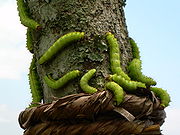
Assam Silk
Encyclopedia
Assam silk denotes the three major types of indigenous wild silk
s produced in Assam
—golden Muga, white Pat and warm Eri silk. The Assam silk industry, now centered in Sualkuchi
, is a labor intensive industry.
 Muga silk is the product of the silkworm Antheraea assamensis
Muga silk is the product of the silkworm Antheraea assamensis
endemic to Assam. The larvae
of these moths feed on som (Machilus bombycina) and sualu (Litsaea polyantha) leaves. The silk produced is known for its glossy fine texture and durability. Due to its low porosity the Muga yarn cannot be bleached or dyed and its natural golden color is retained. This silk can be hand-washed with its lustre increasing after every wash. Very often the silk outlives its owner.
Assam
has received a geographical indication
for the production of Muga.
Eri silk is made by Samia cynthia ricini
which feed on leaves of Castor oil plant
(Ricinus communis). It is also known as Endi or Errandi silk. Because manufacturing process of Eri allows the pupae to develop into adults and only the open ended cocoons are used for turning into silk , it is also popularly known as non-violent silk. This silk is soft and warm and is popular as shawls and quilts.
Wild silk
Wild silks have been known and used in many countries from early times, although the scale of production is far smaller than that from cultivated silkworms.-Background:...
s produced in Assam
Assam
Assam , also, rarely, Assam Valley and formerly the Assam Province , is a northeastern state of India and is one of the most culturally and geographically distinct regions of the country...
—golden Muga, white Pat and warm Eri silk. The Assam silk industry, now centered in Sualkuchi
Sualkuchi
Sualkuchi is a census town in Kamrup district in the Indian state of Assam. It is situated on the north bank of the river Brahmaputra, about 35 km from Guwahati, Sualkuchi is a block of Kamrup District...
, is a labor intensive industry.
Muga silk

Antheraea assamensis
The Muga Silkworm is the larva of the Assam Silkmoth , a moth of the Saturniidae family. It is found in India , Burma and Sundaland....
endemic to Assam. The larvae
Larvae
In Roman mythology, lemures were shades or spirits of the restless or malignant dead, and are probably cognate with an extended sense of larvae as disturbing or frightening...
of these moths feed on som (Machilus bombycina) and sualu (Litsaea polyantha) leaves. The silk produced is known for its glossy fine texture and durability. Due to its low porosity the Muga yarn cannot be bleached or dyed and its natural golden color is retained. This silk can be hand-washed with its lustre increasing after every wash. Very often the silk outlives its owner.
Assam
Assam
Assam , also, rarely, Assam Valley and formerly the Assam Province , is a northeastern state of India and is one of the most culturally and geographically distinct regions of the country...
has received a geographical indication
Geographical indication
A geographical indication is a name or sign used on certain products which corresponds to a specific geographical location or origin...
for the production of Muga.
Pat silk
Pat silk is produced by silkworms which feed on mulberry (Morus spp.) leaves. It is usually brilliant white or off-white in colour. Its cloth can dry in shadow.Eri silk
Eri silk is made by Samia cynthia ricini
Samia cynthia
The Ailanthus silkmoth is a saturniid moth, used to produce silk fabric but not as domesticated as the silkworm, Bombyx mori. The moth has very large wings of 113-125 mm, with a quarter-moon shaped spot on both the upper and lower wings, whitish and yellow stripes and brown background...
which feed on leaves of Castor oil plant
Castor oil plant
The castor oil plant, Ricinus communis, is a species of flowering plant in the spurge family, Euphorbiaceae. It belongs to a monotypic genus, Ricinus, and subtribe, Ricininae. The evolution of castor and its relation to other species are currently being studied.Its seed is the castor bean which,...
(Ricinus communis). It is also known as Endi or Errandi silk. Because manufacturing process of Eri allows the pupae to develop into adults and only the open ended cocoons are used for turning into silk , it is also popularly known as non-violent silk. This silk is soft and warm and is popular as shawls and quilts.

